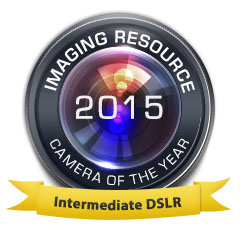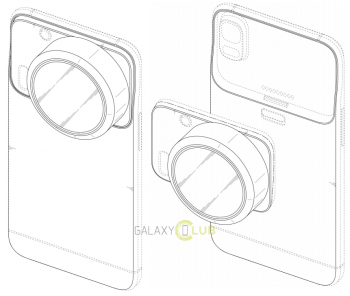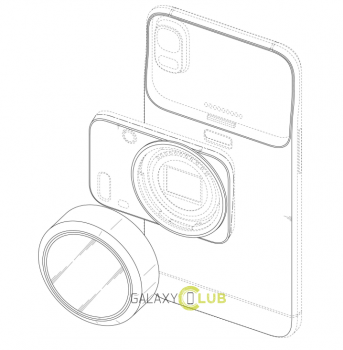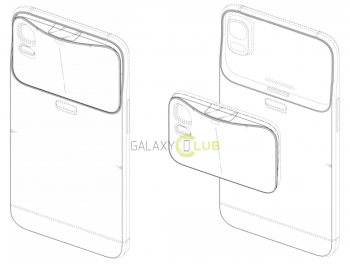The Imaging Resource Camera of the Year Awards Best Enthusiast and Pro Cameras of 2015
For the enthusiast and professional camera market, it was, in a number of cases, the year of the "Mark II" -- many of the new models in this segment came as upgrades to previous models and built upon or improved a previous camera. Despite the "II" moniker on most our favorites in this category, there's more to these cameras than a simple refresh. Rather, each offers significant and welcomed feature improvements, performance boosts, and all around new features and technologies that culminate with thoroughly impressive, high-performance cameras for serious photographers.
One of the major characteristics of this segment in 2015 was a resurgence, in a way, of the "megapixel race," or at least an emphasis on higher resolution capabilities for stills and/or video. We saw the introduction of the Canon 5DS and 5DS R cameras sporting massive 50-megapixel full-frame sensors. Both Olympus and Pentax, with the E-M5 II and K-3 II, respectively, debuted with innovative and impressive in-camera high-resolution shooting modes. We also saw the Panasonic GX8 come out with the highest resolution Four Thirds sensor yet, and Sony's popular RX10 all-in-one got the Mark II treatment as well, adding in higher-res 4K video capabilities, for instance.
We also saw a number of performance enhancements and improvements. The Nikon D7200 answered a big complaint that we had with the D7100's limited buffer depth. The Sony A7S II, though maintaining its rather low-res full-frame sensor, got a big makeover with a better design, better autofocus, in-camera 4K and 5-axis image stabilization, just to name a few.
So, let's get on with the show. Time to dive into the Best Enthusiast and Pro Cameras of 2015…
Camera of the Year, Best Enthusiast Zoom: Sony RX10 II
Take a glance at the Sony RX10 II, and you could be forgiven for thinking you were looking at a DSLR. Like many long-zoom cameras, the RX10 II's styling certainly reinforces that perception, but underneath its skin this isn't a DSLR, but one seriously impressive fixed-lens enthusiast zoom. While the RX10 II's body and bright 24-200mm f/2.8 zoom lens are basically unchanged, a brand-new image sensor offers great image quality, boosts performance to a whopping 14 frames per second in Speed Priority Continuous mode, provides for much faster autofocus, and even enables in-camera 4K video capture.
As if that wasn't enough, the RX10 II also offers a really cool function allowing anywhere from a 4x to 40x slow-motion effect from capture rates as high as 1,000 frames per second. We've seen the same feature on the pocket-friendly RX100 IV as well, but take our word for it: The RX10 II's much more far-reaching lens makes it a whole lot more fun to play with! And there's plenty more: A really great viewfinder and tilting LCD for easy framing, while in-camera Wi-Fi / NFC provide intuitive photo sharing. The Sony RX10 II makes a really great argument for ditching your larger-sensored camera and bag full of lenses, and switching to a veritable Swiss army knife of a camera which lets you travel light without sacrificing on zoom reach!
Buy the Sony RX10 II: Amazon | Adorama | B&H Photo
Camera of the Year, Best Enthusiast Mirrorless:Olympus E-M5 II
The original E-M5 took the photo world by storm in 2012, introducing a cool, retro-inspired yet enthusiast-oriented, high-performance mirrorless camera. With a compact, weather-sealed body and a bunch of neat amenities like in-body image stabilization, not to mention great image quality, the E-M5 was a tough act to follow. Three years in the making, and the Olympus E-M5 Mark II is here, and it's wonderful.
Subtle, yet welcomed design tweaks abound with improved buttons, reconfigured control dials, a brighter and sharper EVF, and a new tilt-swivel LCD -- all while maintaining weather-sealing. Under the hood, things are even more interesting. There's a vastly improved AF system with an 81-area array, faster burst shooting, and better 5-axis I.S. One very cool new feature is the High Resolution Mode, which moves the sensor slightly throughout an 8-shot burst to produce a massive 40-megapixel JPEG or a 64-megapixel RAW file! The resulting images are simply amazing, with detail that competes with full-frame cameras -- and, dare we say, some medium-format cameras given the right post-processing.
All told, the Olympus E-M5 Mark II continues the legacy of the E-M5 and improves it in a number of areas. Combined with Olympus' impressive and ever-growing collection of fantastic lenses (not to mention a number of other third-party brands as well as Panasonic glass), the Olympus E-M5 Mark II is our favorite for the enthusiast photographer looking to downsize from the DSLR or upgrade from a point-and-shoot.
Buy the E-M5 II body only in silver: Amazon | Adorama | B&H PhotoBuy the E-M5 II body only in black: Amazon | Adorama | B&H Photo
Camera of Distinction, Enthusiast Mirrorless: Panasonic GX8
The GX7 was a widely popular camera for Panasonic, and for good reason -- great image quality, stylish but robust design and all-around good performance. Now with the updated Panasonic GX8, the new flagship GX model, improves not only the resolution with a higher-res 20MP sensor, but also ups the specs for both AF performance and burst rate.
One of the major new features on the Panasonic GX8 is Dual I.S. The GX7 was, until now, the only Lumix camera with body-based image stabilization. Now, with the GX8, you can take advantage of both optical I.S. and the body-based I.S. simultaneously for improved stabilization. Combined with other niceties like 4K video, 4K Photo, built-in Wi-Fi and NFC, and weather-sealed construction, the Panasonic GX8 makes for a very compelling and capable camera.
Buy the GX8 body only in black: Amazon | Adorama | B&H PhotoBuy the GX8 body only in black: Amazon | Adorama | B&H Photo
Camera of the Year, Best Enthusiast DSLR: Nikon D7200
At first glance, the Nikon D7200 almost appears to be a re-branded D7100. That's not necessarily a bad thing, as that camera got plenty of high marks from us. However, there were a few issues -- namely, the limited buffer depth -- that were cause for concern, particularly for those who shoot lots of sports or wildlife. Thankfully, Nikon answered with the D7200 and pumped up the buffer threefold, if not more, thanks to an upgrade to the EXPEED 4 image processor.
The Nikon D7200 maintains a lot of the impressive specs from its predecessor: a high-resolution, 24-megapixel APS-C sensor with no low-pass filter for increased detail; great high-ISO performance; a versatile and flexible AF system; dual SD card slots; and long-lasting battery life.
With a comfortable, rugged, and weather-sealed body, the Nikon D7200 offers a lot of camera for the money. For Nikon shooters looking to upgrade or those serious photographers looking to make a big splash into the DSLR arena, the D7200 is a serious camera worthy of a close look. With excellent image quality and great performance, the Nikon D7200 is our call for the best enthusiast DSLR of 2015.
Buy the D7200 in a kit with 18-140mm lens: Amazon | Adorama | B&H PhotoBuy the D7200 body only: Amazon | Adorama | B&H Photo
Camera of Distinction, Enthusiast DSLR: Pentax K-3 II
The Pentax K-3 II is a camera with quite a heritage behind it. We've been huge fans of the company's flagship DSLRs since the original K-7 launched all the way back in 2009, and the closely-related K-3 received an Award of Distinction in our 2013 Camera of the Year awards. Now, the K-3 II takes what's mostly the same design as that camera and courts fans of the great outdoors with a couple of key changes. Gone is the popup flash, since enthusiasts and pros aren't typically great fans of on-camera lighting. In its place is a GPS receiver with which to record the location at which each image was captured. Even cooler, it serves double-duty in allowing the K-3 II to freeze star trails in AstroTracer mode as well.
And if you predominantly shoot still life, landscapes or other subjects with little or no subject motion, we've saved the best for last. An uprated image stabilization system now lets the K-3 II boost resolution by capturing several shots in quick succession, giving you even greater per-pixel sharpness whenever you need it. Like its predecessor, the Pentax K-3 II is a really great camera that's packed to the gills with cool features at a very reasonable price!
Buy the Pentax K-3 II body only: Amazon | Adorama | B&H Photo
Camera of the Year, Best Low Light Camera: Sony A7S II
The digital camera market has come a very long way in the last decade, but the mighty megapixel has reigned supreme for too much of that time. With the A7S II, Sony takes a different road, fielding a camera whose raison d'être is sensitivity. Like last year's A7S, the Sony A7S II opts for a relatively low -- and yet arguably still sufficient for many purposes -- twelve megapixel sensor with comparatively huge, light-hungry pixels.
Thanks to that decision, the A7S II retains the ability to shoot handheld almost without regard to the ambient lighting conditions. And it's an even better camera than was its predecessor, with more comfortable ergonomics, a new five-axis, in-body image stabilization system and a vastly improved video feature set complete with 4K recording in-camera using the full sensor width. No question about it: If you want to free yourself from flash strobes and off-camera lighting, the Sony A7S II is the camera you need!
Buy the A7S II body only: Amazon | Adorama | B&H Photo
Camera of the Year, Best Professional Camera: Canon 5DS/R
If you thought the megapixel war was winding down, think again. The Canon 5DS and 5DS R cameras take full-frame DSLRs to the next level with whopping 50.6 megapixels-worth of resolution. Offered as a pair of models -- one with and one without an optical low-pass filter -- the Canon 5DS pair two of Canon's most niche-market DSLRs, with a focus squarely on high-end, professional users demanding extreme resolving power for landscapes, portraits, nature and architectural subjects.
Housed in a body nearly identical to the 5D Mark III, the "S" models are familiar territory for long-time Canon owners, with comfortable ergonomics and no-nonsense controls. The image quality is simply stunning, with incredible detail especially at lower ISOs. And though high ISO isn't a strong suit of these cameras, their performance in this area is quite decent.
These certainly aren't cameras for everyone or for all subject matter. The high resolution puts more emphasis on technique, especially on nailing your focus to ensure the sharpest photos. Also, their speed and video chops are not as robust as other DSLRs, like the 7D Mark II or 5D Mark III. But, if you want extreme resolution from a Canon EOS camera -- without making the jump to medium format -- the Canon 5DS or the Canon 5DS R is the answer.
Buy the 5DS body only: Amazon | Adorama | B&H PhotoBuy the 5DS R body only: Amazon | Adorama | B&H Photo
Follow the rest of the awards!
Best Zoom & Prime Lenses of 2015
Best Compact, Fixed-lens and Unique Cameras of 2015
Best Entry-level and Intermediate Cameras of 2015
Best Enthusiast and Pro Cameras of 2015 (current page)
Printers, New Technologies and Best Overall of 2015 (December 21st @ 2pm EDT)
Source:
Cameras of the Year: Best Enthusiast and Pro Cameras of 2015
The company's mirrorless NX line has been around since 2010, but a recent spate of rumors and news have left its future in question. The rumor mill started buzzing about Samsung exiting the camera business entirely, and while the company quickly denied it, there have been signs that some sort of shakeup is coming. It has stopped sales of its flagship NX1 in the UK, and is phasing out sales in Germany.









 (emiliokuffer/Flickr) Tweet Share Share on Facebook Tweet Share Pin Share
(emiliokuffer/Flickr) Tweet Share Share on Facebook Tweet Share Pin Share 
